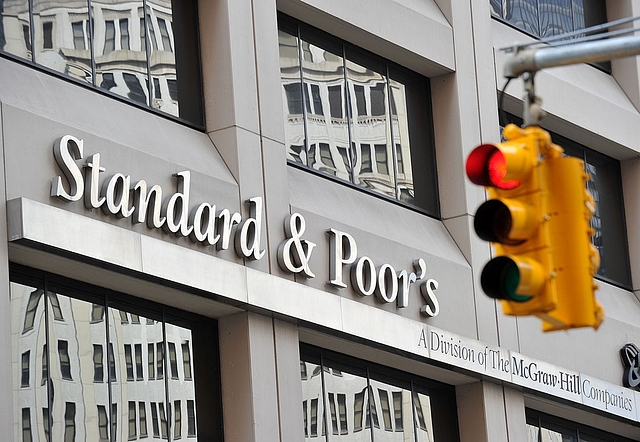
Rating Agency S&P Reaffirms India’s Long-Term Sovereign Credit Rating, Outlook As ‘Stable’
S&P Global Ratings on Wednesday maintained India's sovereign credit ratings, affirming its ''BBB-'' long-term and ''A-3'' short-term unsolicited foreign and local currency ratings.
Besides, S&P Global Ratings said India's outlook on the long-term rating is stable.
"The stable outlook reflects our expectation that India's economy will recover following the containment of the Covid-19 pandemic, and the country will maintain its sound net external position," the ratings agency statement said.
"The stable outlook also assumes that the government''s fiscal deficit will recede markedly following a multi-year high in fiscal year 2021 (ending March 31, 2021)."
In terms of the rating rationale, the agency said that it reflects the country's above-average real GDP growth, sound external profile, and evolving monetary settings, amongst others.
These are balanced against vulnerabilities stemming from the country's low per capita income and consistently elevated fiscal deficits that contribute to high general government debt, net of liquid assets, it said.
"India's economy will contract in fiscal 2021, largely owing to the impact of the Covid-19 pandemic. We forecast a 5 per cent decline in real GDP growth, which would be the worst economic performance in recent history," the statement said.
"The global economic downturn resulting from the pandemic, along with strict domestic measures aimed at containing the spread of the local epidemic, are hitting the economy hard, and will likely result in a significant fall in activity in the first quarter of this fiscal year (i.e., three months from April 1, 2020)."
As per the statement, productive capacity has been severely disrupted during this period, and millions of workers have left their jobs to return home, sometimes crossing the country to do so.
"India's labour markets have therefore weakened dramatically, and may take some time to heal," the statement said.
Nevertheless,it said that even after incorporating a deep contraction this fiscal year, India's economy continues to outperform peers at a similar level of income on a 10-year, weighted average, real GDP per capita basis.
However, the ratings agency warned that new risks are emerging that could undermine the economy's recovery, even beyond the containment of Covid-19.
"Prior to the onset of the pandemic, India's GDP growth rate had already slowed measurably," the statement said.
"Existing vulnerabilities including a weak financial sector, rigid labour markets, and consistently weak private investment could hamper India's recovery if they are not actively addressed."
Furthermore, tighter lending conditions continue across the financial system, particularly in the public sector, it said.
"This is reflected in a gradual decline in credit growth, which is likely to remain weak owing to subdued demand and limited risk appetite by the banks," the statement said.
"Liquidity concerns in some parts of the non-bank financial institution (NBFI) sector have also re-emerged since the onset of the Covid-19 crisis."
Nevertheless, it said that India's economy is "likely to achieve a strong recovery following the deep contraction in this fiscal year; we forecast real GDP growth at 8.5 per cent in fiscal 2022".
"The economy's long-term out-performance highlights its resilience," the statement said.
"India's wide range of structural trends, including healthy demographics and competitive unit labour costs, work in its favour. A more favourable corporate tax regime, which is particularly supportive of manufacturing firms, should reinforce growth, alongside additional fiscal and monetary easing."
Commenting on the ratings action, Joseph Thomas, Head of Research - Emkay Wealth Management, said: "At present, the ratings by all the agencies are at the same level. Moody''s brought it at an even level with S&P. Therefore, there is nothing new in this. Also, there is an acceptance that the long term prospects for the domestic economy is quite bright. Relatively higher GDP growth compared to other countries, and sound forex reserves, and pro-active central bank policies may help the economy to tide over the waves of crisis faster."
"But the risks remain, on the fiscal front with a ballooning fiscal deficit, both at the centre and states, uncertain trajectory of inflation etc. There is an urgent need for revival of employment and demand generation, through the time-tested and classic Keynesian tools like the MNREGA."
According to V. K, Vijayakumar, Chief Investment Strategist at Geojit Financial Services: "SP's rating affirmation of India at BBB has come as a relief. The markets were worried about a potential downgrade with disastrous consequences. Now, since that threat is out of the way, the government should focus on walking the talk on reforms. In its ratings affirmation, S&P has said that it expects the recent reforms to continue and that fiscal consolidation is likely after FY21."
"India should deliver on that. In the context of S&P's rating affirmation, Moody's is not likely to further downgrade India''s rating. They are likely to watch the implementation of recent reforms and attempts at fiscal consolidation in FY 22, particularly the roadmap for that. Fiscal expansion in FY 21 is global."
The ratings development comes after Moody's Investors Services downgraded India's sovereign ratings as it sees challenges piled up on the country''s policy-making institutions to mitigate the risks of a sustained period of relatively low growth.
Consequently, Moody's downgraded India's foreign currency and local currency long-term issuer ratings to Baa3 from Baa2.